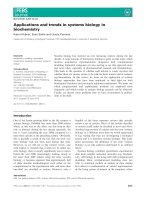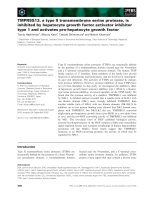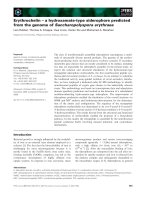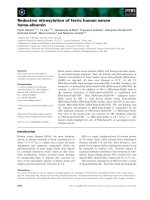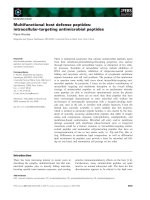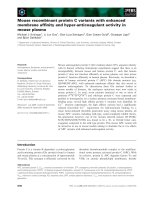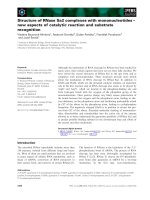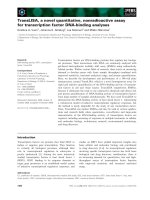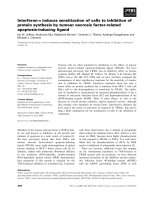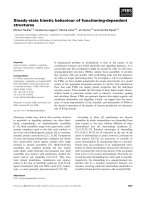Tài liệu Báo cáo khoa học: "WebCAGe – A Web-Harvested Corpus Annotated with GermaNet Senses" docx
Bạn đang xem bản rút gọn của tài liệu. Xem và tải ngay bản đầy đủ của tài liệu tại đây (973.58 KB, 10 trang )
Proceedings of the 13th Conference of the European Chapter of the Association for Computational Linguistics, pages 387–396,
Avignon, France, April 23 - 27 2012.
c
2012 Association for Computational Linguistics
WebCAGe – A Web-Harvested Corpus Annotated with GermaNet Senses
Verena Henrich, Erhard Hinrichs, and Tatiana Vodolazova
University of T
¨
ubingen
Department of Linguistics
{firstname.lastname}@uni-tuebingen.de
Abstract
This paper describes an automatic method
for creating a domain-independent sense-
annotated corpus harvested from the web.
As a proof of concept, this method has
been applied to German, a language for
which sense-annotated corpora are still in
short supply. The sense inventory is taken
from the German wordnet GermaNet. The
web-harvesting relies on an existing map-
ping of GermaNet to the German version
of the web-based dictionary Wiktionary.
The data obtained by this method consti-
tute WebCAGe (short for: Web-Harvested
Corpus Annotated with GermaNet Senses),
a resource which currently represents the
largest sense-annotated corpus available for
German. While the present paper focuses
on one particular language, the method as
such is language-independent.
1 Motivation
The availability of large sense-annotated corpora
is a necessary prerequisite for any supervised and
many semi-supervised approaches to word sense
disambiguation (WSD). There has been steady
progress in the development and in the perfor-
mance of WSD algorithms for languages such as
English for which hand-crafted sense-annotated
corpora have been available (Agirre et al., 2007;
Erk and Strapparava, 2012; Mihalcea et al., 2004),
while WSD research for languages that lack these
corpora has lagged behind considerably or has
been impossible altogether.
Thus far, sense-annotated corpora have typi-
cally been constructed manually, making the cre-
ation of such resources expensive and the com-
pilation of larger data sets difficult, if not com-
pletely infeasible. It is therefore timely and ap-
propriate to explore alternatives to manual anno-
tation and to investigate automatic means of cre-
ating sense-annotated corpora. Ideally, any auto-
matic method should satisfy the following crite-
ria:
(1) The method used should be language inde-
pendent and should be applicable to as many
languages as possible for which the neces-
sary input resources are available.
(2) The quality of the automatically generated
data should be extremely high so as to be us-
able as is or with minimal amount of manual
post-correction.
(3) The resulting sense-annotated materials (i)
should be non-trivial in size and should be
dynamically expandable, (ii) should not be
restricted to a narrow subject domain, but
be as domain-independent as possible, and
(iii) should be freely available for other re-
searchers.
The method presented below satisfies all of
the above criteria and relies on the following re-
sources as input: (i) a sense inventory and (ii) a
mapping between the sense inventory in question
and a web-based resource such as Wiktionary
1
or
1
/>387
Wikipedia
2
.
As a proof of concept, this automatic method
has been applied to German, a language for which
sense-annotated corpora are still in short supply
and fail to satisfy most if not all of the crite-
ria under (3) above. While the present paper
focuses on one particular language, the method
as such is language-independent. In the case
of German, the sense inventory is taken from
the German wordnet GermaNet
3
(Henrich and
Hinrichs, 2010; Kunze and Lemnitzer, 2002).
The web-harvesting relies on an existing map-
ping of GermaNet to the German version of the
web-based dictionary Wiktionary. This mapping
is described in Henrich et al. (2011). The
resulting resource consists of a web-harvested
corpus WebCAGe (short for: Web-Harvested
Corpus Annotated with GermaNet Senses),
which is freely available at: -
tuebingen.de/en/webcage.shtml
The remainder of this paper is structured as
follows: Section 2 provides a brief overview of
the resources GermaNet and Wiktionary. Sec-
tion 3 introduces the mapping of GermaNet to
Wiktionary and how this mapping can be used
to automatically harvest sense-annotated materi-
als from the web. The algorithm for identifying
the target words in the harvested texts is described
in Section 4. In Section 5, the approach of au-
tomatically creating a web-harvested corpus an-
notated with GermaNet senses is evaluated and
compared to existing sense-annotated corpora for
German. Related work is discussed in Section 6,
together with concluding remarks and an outlook
on future work.
2 Resources
2.1 GermaNet
GermaNet (Henrich and Hinrichs, 2010; Kunze
and Lemnitzer, 2002) is a lexical semantic net-
work that is modeled after the Princeton Word-
Net for English (Fellbaum, 1998). It partitions the
2
/>3
Using a wordnet as the gold standard for the sense inven-
tory is fully in line with standard practice for English where
the Princeton WordNet (Fellbaum, 1998) is typically taken
as the gold standard.
lexical space into a set of concepts that are inter-
linked by semantic relations. A semantic concept
is represented as a synset, i.e., as a set of words
whose individual members (referred to as lexical
units) are taken to be (near) synonyms. Thus, a
synset is a set-representation of the semantic rela-
tion of synonymy.
There are two types of semantic relations in
GermaNet. Conceptual relations hold between
two semantic concepts, i.e. synsets. They in-
clude relations such as hypernymy, part-whole re-
lations, entailment, or causation. Lexical rela-
tions hold between two individual lexical units.
Antonymy, a pair of opposites, is an example of a
lexical relation.
GermaNet covers the three word categories of
adjectives, nouns, and verbs, each of which is
hierarchically structured in terms of the hyper-
nymy relation of synsets. The development of
GermaNet started in 1997, and is still in progress.
GermaNet’s version 6.0 (release of April 2011)
contains 93407 lexical units, which are grouped
into 69594 synsets.
2.2 Wiktionary
Wiktionary is a web-based dictionary that is avail-
able for many languages, including German. As
is the case for its sister project Wikipedia, it
is written collaboratively by volunteers and is
freely available
4
. The dictionary provides infor-
mation such as part-of-speech, hyphenation, pos-
sible translations, inflection, etc. for each word.
It includes, among others, the same three word
classes of adjectives, nouns, and verbs that are
also available in GermaNet. Distinct word senses
are distinguished by sense descriptions and ac-
companied with example sentences illustrating
the sense in question.
Further, Wiktionary provides relations to
other words, e.g., in the form of synonyms,
antonyms, hypernyms, hyponyms, holonyms, and
meronyms. In contrast to GermaNet, the relations
are (mostly) not disambiguated.
For the present project, a dump of the Ger-
man Wiktionary as of February 2, 2011 is uti-
4
Wiktionary is available under the Cre-
ative Commons Attribution/Share-Alike license
/>388
Figure 1: Sense mapping of GermaNet and Wiktionary using the example of Bogen.
lized, consisting of 46457 German words com-
prising 70339 word senses. The Wiktionary data
was extracted by the freely available Java-based
library JWKTL
5
.
3 Creation of a Web-Harvested Corpus
The starting point for creating WebCAGe is an
existing mapping of GermaNet senses with Wik-
tionary sense definitions as described in Henrich
et al. (2011). This mapping is the result of a
two-stage process: i) an automatic word overlap
alignment algorithm in order to match GermaNet
senses with Wiktionary sense descriptions, and
ii) a manual post-correction step of the automatic
alignment. Manual post-correction can be kept at
a reasonable level of effort due to the high accu-
racy (93.8%) of the automatic alignment.
The original purpose of this mapping was to
automatically add Wiktionary sense descriptions
to GermaNet. However, the alignment of these
two resources opens up a much wider range of
5
/>possibilities for data mining community-driven
resources such as Wikipedia and web-generated
content more generally. It is precisely this poten-
tial that is fully exploited for the creation of the
WebCAGe sense-annotated corpus.
Fig. 1 illustrates the existing GermaNet-
Wiktionary mapping using the example word Bo-
gen. The polysemous word Bogen has three dis-
tinct senses in GermaNet which directly corre-
spond to three separate senses in Wiktionary
6
.
Each Wiktionary sense entry contains a definition
and one or more example sentences illustrating
the sense in question. The examples in turn are
often linked to external references, including sen-
tences contained in the German Gutenberg text
archive
7
(see link in the topmost Wiktionary sense
entry in Fig. 1), Wikipedia articles (see link for
the third Wiktionary sense entry in Fig. 1), and
other textual sources (see the second sense en-
try in Fig. 1). It is precisely this collection of
6
Note that there are further senses in both resources not
displayed here for reasons of space.
7
/>389
Figure 2: Sense mapping of GermaNet and Wiktionary using the example of Archiv.
heterogeneous material that can be harvested for
the purpose of compiling a sense-annotated cor-
pus. Since the target word (rendered in Fig. 1
in bold face) in the example sentences for a par-
ticular Wiktionary sense is linked to a GermaNet
sense via the sense mapping of GermaNet with
Wiktionary, the example sentences are automati-
cally sense-annotated and can be included as part
of WebCAGe.
Additional material for WebCAGe is harvested
by following the links to Wikipedia, the Guten-
berg archive, and other web-based materials. The
external webpages and the Gutenberg texts are ob-
tained from the web by a web-crawler that takes
some URLs as input and outputs the texts of the
corresponding web sites. The Wikipedia articles
are obtained by the open-source Java Wikipedia
Library JWPL
8
. Since the links to Wikipedia, the
Gutenberg archive, and other web-based materials
also belong to particular Wiktionary sense entries
that in turn are mapped to GermaNet senses, the
target words contained in these materials are au-
tomatically sense-annotated.
Notice that the target word often occurs more
8
/>than once in a given text. In keeping with
the widely used heuristic of “one sense per dis-
course”, multiple occurrences of a target word in
a given text are all assigned to the same GermaNet
sense. An inspection of the annotated data shows
that this heuristic has proven to be highly reliable
in practice. It is correct in 99.96% of all target
word occurrences in the Wiktionary example sen-
tences, in 96.75% of all occurrences in the exter-
nal webpages, and in 95.62% of the Wikipedia
files.
WebCAGe is developed primarily for the pur-
pose of the word sense disambiguation task.
Therefore, only those target words that are gen-
uinely ambiguous are included in this resource.
Since WebCAGe uses GermaNet as its sense in-
ventory, this means that each target word has at
least two GermaNet senses, i.e., belongs to at least
two distinct synsets.
The GermaNet-Wiktionary mapping is not al-
ways one-to-one. Sometimes one GermaNet
sense is mapped to more than one sense in Wik-
tionary. Fig. 2 illustrates such a case. For
the word Archiv each resource records three dis-
tinct senses. The first sense (‘data repository’)
390
in GermaNet corresponds to the first sense in
Wiktionary, and the second sense in GermaNet
(‘archive’) corresponds to both the second and
third senses in Wiktionary. The third sense in
GermaNet (‘archived file’) does not map onto any
sense in Wiktionary at all. As a result, the word
Archiv is included in the WebCAGe resource with
precisely the sense mappings connected by the
arrows shown in Fig. 2. The fact that the sec-
ond GermaNet sense corresponds to two sense
descriptions in Wiktionary simply means that the
target words in the example are both annotated by
the same sense. Furthermore, note that the word
Archiv is still genuinely ambiguous since there is
a second (one-to-one) mapping between the first
senses recorded in GermaNet and Wiktionary, re-
spectively. However, since the third GermaNet
sense is not mapped onto any Wiktionary sense at
all, WebCAGe will not contain any example sen-
tences for this particular GermaNet sense.
The following section describes how the target
words within these textual materials can be auto-
matically identified.
4 Automatic Detection of Target Words
For highly inflected languages such as German,
target word identification is more complex com-
pared to languages with an impoverished inflec-
tional morphology, such as English, and thus re-
quires automatic lemmatization. Moreover, the
target word in a text to be sense-annotated is
not always a simplex word but can also appear
as subpart of a complex word such as a com-
pound. Since the constituent parts of a compound
are not usually separated by blank spaces or hy-
phens, German compounding poses a particular
challenge for target word identification. Another
challenging case for automatic target word detec-
tion in German concerns particle verbs such as an-
k
¨
undigen ‘announce’. Here, the difficulty arises
when the verbal stem (e.g., k
¨
undigen) is separated
from its particle (e.g., an) in German verb-initial
and verb-second clause types.
As a preprocessing step for target word identi-
fication, the text is split into individual sentences,
tokenized, and lemmatized. For this purpose, the
sentence detector and the tokenizer of the suite
of Apache OpenNLP tools
9
and the TreeTagger
(Schmid, 1994) are used. Further, compounds
are split by using BananaSplit
10
. Since the au-
tomatic lemmatization obtained by the tagger and
the compound splitter are not 100% accurate, tar-
get word identification also utilizes the full set of
inflected forms for a target word whenever such
information is available. As it turns out, Wik-
tionary can often be used for this purpose as well
since the German version of Wiktionary often
contains the full set of word forms in tables
11
such
as the one shown in Fig. 3 for the word Bogen.
Figure 3: Wiktionary inflection table for Bogen.
Fig. 4 shows an example of such a sense-
annotated text for the target word Bogen ‘vi-
olin bow’. The text is an excerpt from the
Wikipedia article Violine ‘violin’, where the target
word (rendered in bold face) appears many times.
Only the second occurrence shown in the figure
(marked with a 2 on the left) exactly matches the
word Bogen as is. All other occurrences are ei-
ther the plural form B
¨
ogen (4 and 7), the geni-
tive form Bogens (8), part of a compound such
as Bogenstange (3), or the plural form as part
of a compound such as in Fernambukb
¨
ogen and
Sch
¨
ulerb
¨
ogen (5 and 6). The first occurrence
of the target word in Fig. 4 is also part of a
compound. Here, the target word occurs in the
singular as part of the adjectival compound bo-
gengestrichenen.
For expository purposes, the data format shown
in Fig. 4 is much simplified compared to the ac-
tual, XML-based format in WebCAGe. The infor-
9
/>10
/>11
The inflection table cannot be extracted with the Java
Wikipedia Library JWPL. It is rather extracted from the Wik-
tionary dump file.
391
Figure 4: Excerpt from Wikipedia article Violine ‘violin’ tagged with target word Bogen ‘violin bow’.
mation for each occurrence of a target word con-
sists of the GermaNet sense, i.e., the lexical unit
ID, the lemma of the target word, and the Ger-
maNet word category information, i.e., ADJ for
adjectives, NN for nouns, and VB for verbs.
5 Evaluation
In order to assess the effectiveness of the ap-
proach, we examine the overall size of WebCAGe
and the relative size of the different text col-
lections (see Table 1), compare WebCAGe to
other sense-annotated corpora for German (see
Table 2), and present a precision- and recall-based
evaluation of the algorithm that is used for auto-
matically identifying target words in the harvested
texts (see Table 3).
Table 1 shows that Wiktionary (7644 tagged
word tokens) and Wikipedia (1732) contribute
by far the largest subsets of the total number of
tagged word tokens (10750) compared with the
external webpages (589) and the Gutenberg texts
(785). These tokens belong to 2607 distinct pol-
ysemous words contained in GermaNet, among
which there are 211 adjectives, 1499 nouns, and
897 verbs (see Table 2). On average, these words
have 2.9 senses in GermaNet (2.4 for adjectives,
2.6 for nouns, and 3.6 for verbs).
Table 2 also shows that WebCAGe is consid-
erably larger than the other two sense-annotated
corpora available for German ((Broscheit et al.,
2010) and (Raileanu et al., 2002)). It is impor-
tant to keep in mind, though, that the other two
resources were manually constructed, whereas
WebCAGe is the result of an automatic harvesting
method. Such an automatic method will only con-
stitute a viable alternative to the labor-intensive
manual method if the results are of sufficient qual-
ity so that the harvested data set can be used as is
or can be further improved with a minimal amount
of manual post-editing.
For the purpose of the present evaluation, we
conducted a precision- and recall-based analy-
sis for the text types of Wiktionary examples,
external webpages, and Wikipedia articles sep-
392
Table 1: Current size of WebCAGe.
Wiktionary External Wikipedia Gutenberg All
examples webpages articles texts texts
Number of
tagged
word
tokens
adjectives 575 31 79 28 713
nouns 4103 446 1643 655 6847
verbs 2966 112 10 102 3190
all word classes 7644 589 1732 785 10750
Number of
tagged
sentences
adjectives 565 31 76 26 698
nouns 3965 420 1404 624 6413
verbs 2945 112 10 102 3169
all word classes 7475 563 1490 752 10280
Total
number of
sentences
adjectives 623 1297 430 65030 67380
nouns 4184 9630 6851 376159 396824
verbs 3087 5285 263 146755 155390
all word classes 7894 16212 7544 587944 619594
Table 2: Comparing WebCAGe to other sense-tagged corpora of German.
WebCAGe
Broscheit et Raileanu et
al., 2010 al., 2002
Sense
tagged
words
adjectives 211 6 0
nouns 1499 18 25
verbs 897 16 0
all word classes 2607 40 25
Number of tagged word tokens 10750 approx. 800 2421
Domain independent yes yes
medical
domain
arately for the three word classes of adjectives,
nouns, and verbs. Table 3 shows that precision
and recall for all three word classes that occur
for Wiktionary examples, external webpages, and
Wikipedia articles lies above 92%. The only size-
able deviations are the results for verbs that occur
in the Gutenberg texts. Apart from this one excep-
tion, the results in Table 3 prove the viability of
the proposed method for automatic harvesting of
sense-annotated data. The average precision for
all three word classes is of sufficient quality to be
used as-is if approximately 2-5% noise in the an-
notated data is acceptable. In order to eliminate
such noise, manual post-editing is required. How-
ever, such post-editing is within acceptable lim-
its: it took an experienced research assistant a to-
tal of 25 hours to hand-correct all the occurrences
of sense-annotated target words and to manually
sense-tag any missing target words for the four
text types.
6 Related Work and Future Directions
With relatively few exceptions to be discussed
shortly, the construction of sense-annotated cor-
pora has focussed on purely manual methods.
This is true for SemCor, the WordNet Gloss Cor-
pus, and for the training sets constructed for En-
glish as part of the SensEval and SemEval shared
task competitions (Agirre et al., 2007; Erk and
Strapparava, 2012; Mihalcea et al., 2004). Purely
manual methods were also used for the German
sense-annotated corpora constructed by Broscheit
et al. (2010) and Raileanu et al. (2002) as well as
for other languages including the Bulgarian and
393
Table 3: Evaluation of the algorithm of identifying the target words.
Wiktionary External Wikipedia Gutenberg
examples webpages articles texts
Precision
adjectives 97.70% 95.83% 99.34% 100%
nouns 98.17% 98.50% 95.87% 92.19%
verbs 97.38% 92.26% 100% 69.87%
all word classes 97.32% 96.19% 96.26% 87.43%
Recall
adjectives 97.70% 97.22% 98.08% 97.14%
nouns 98.30% 96.03% 92.70.% 97.38%
verbs 97.51% 99.60% 100% 89.20%
all word classes 97.94% 97.32% 93.36% 95.42%
the Chinese sense-tagged corpora (Koeva et al.,
2006; Wu et al., 2006). The only previous at-
tempts of harvesting corpus data for the purpose
of constructing a sense-annotated corpus are the
semi-supervised method developed by Yarowsky
(1995), the knowledge-based approach of Lea-
cock et al. (1998), later also used by Agirre and
Lopez de Lacalle (2004), and the automatic asso-
ciation of Web directories (from the Open Direc-
tory Project, ODP) to WordNet senses by Santa-
mar
´
ıa et al. (2003).
The latter study (Santamar
´
ıa et al., 2003) is
closest in spirit to the approach presented here.
It also relies on an automatic mapping between
wordnet senses and a second web resource. While
our approach is based on automatic mappings be-
tween GermaNet and Wiktionary, their mapping
algorithm maps WordNet senses to ODP subdi-
rectories. Since these ODP subdirectories contain
natural language descriptions of websites relevant
to the subdirectory in question, this textual mate-
rial can be used for harvesting sense-specific ex-
amples. The ODP project also covers German so
that, in principle, this harvesting method could be
applied to German in order to collect additional
sense-tagged data for WebCAGe.
The approach of Yarowsky (1995) first collects
all example sentences that contain a polysemous
word from a very large corpus. In a second step,
a small number of examples that are representa-
tive for each of the senses of the polysemous tar-
get word is selected from the large corpus from
step 1. These representative examples are manu-
ally sense-annotated and then fed into a decision-
list supervised WSD algorithm as a seed set for it-
eratively disambiguating the remaining examples
collected in step 1. The selection and annotation
of the representative examples in Yarowsky’s ap-
proach is performed completely manually and is
therefore limited to the amount of data that can
reasonably be annotated by hand.
Leacock et al. (1998), Agirre and Lopez de La-
calle (2004), and Mihalcea and Moldovan (1999)
propose a set of methods for automatic harvesting
of web data for the purposes of creating sense-
annotated corpora. By focusing on web-based
data, their work resembles the research described
in the present paper. However, the underlying har-
vesting methods differ. While our approach re-
lies on a wordnet to Wiktionary mapping, their
approaches all rely on the monosemous relative
heuristic. Their heuristic works as follows: In or-
der to harvest corpus examples for a polysemous
word, the WordNet relations such as synonymy
and hypernymy are inspected for the presence of
unambiguous words, i.e., words that only appear
in exactly one synset. The examples found for
these monosemous relatives can then be sense-
annotated with the particular sense of its ambigu-
ous word relative. In order to increase coverage
of the monosemous relatives approach, Mihalcea
and Moldovan (1999) have developed a gloss-
based extension, which relies on word overlap of
the gloss and the WordNet sense in question for
all those cases where a monosemous relative is
not contained in the WordNet dataset.
The approaches of Leacock et al., Agirre and
Lopez de Lacalle, and Mihalcea and Moldovan as
394
well as Yarowsky’s approach provide interesting
directions for further enhancing the WebCAGe re-
source. It would be worthwhile to use the au-
tomatically harvested sense-annotated examples
as the seed set for Yarowsky’s iterative method
for creating a large sense-annotated corpus. An-
other fruitful direction for further automatic ex-
pansion of WebCAGe is to use the heuristic of
monosemous relatives used by Leacock et al., by
Agirre and Lopez de Lacalle, and by Mihalcea
and Moldovan. However, we have to leave these
matters for future research.
In order to validate the language independence
of our approach, we plan to apply our method to
sense inventories for languages other than Ger-
man. A precondition for such an experiment is an
existing mapping between the sense inventory in
question and a web-based resource such as Wik-
tionary or Wikipedia. With BabelNet, Navigli and
Ponzetto (2010) have created a multilingual re-
source that allows the testing of our approach to
languages other than German. As a first step in
this direction, we applied our approach to English
using the mapping between the Princeton Word-
Net and the English version of Wiktionary pro-
vided by Meyer and Gurevych (2011). The re-
sults of these experiments, which are reported in
Henrich et al. (2012), confirm the general appli-
cability of our approach.
To conclude: This paper describes an automatic
method for creating a domain-independent sense-
annotated corpus harvested from the web. The
data obtained by this method for German have
resulted in the WebCAGe resource which cur-
rently represents the largest sense-annotated cor-
pus available for this language. The publication of
this paper is accompanied by making WebCAGe
freely available.
Acknowledgements
The research reported in this paper was jointly
funded by the SFB 833 grant of the DFG and by
the CLARIN-D grant of the BMBF. We would
like to thank Christina Hoppermann, Marie Hin-
richs as well as three anonymous EACL 2012 re-
viewers for their helpful comments on earlier ver-
sions of this paper. We are very grateful to Rein-
hild Barkey, Sarah Schulz, and Johannes Wahle
for their help with the evaluation reported in Sec-
tion 5. Special thanks go to Yana Panchenko and
Yannick Versley for their support with the web-
crawler and to Emanuel Dima and Klaus Sut-
tner for helping us to obtain the Gutenberg and
Wikipedia texts.
References
Agirre, E., Lopez de Lacalle, O. 2004. Publicly
available topic signatures for all WordNet nominal
senses. Proceedings of the 4th International Con-
ference on Languages Resources and Evaluations
(LREC’04), Lisbon, Portugal, pp. 1123–1126
Agirre, E., Marquez, L., Wicentowski, R. 2007. Pro-
ceedings of the 4th International Workshop on Se-
mantic Evaluations. Assoc. for Computational Lin-
guistics, Stroudsburg, PA, USA
Broscheit, S., Frank, A., Jehle, D., Ponzetto, S. P.,
Rehl, D., Summa, A., Suttner, K., Vola, S. 2010.
Rapid bootstrapping of Word Sense Disambigua-
tion resources for German. Proceedings of the 10.
Konferenz zur Verarbeitung Nat
¨
urlicher Sprache,
Saarbr
¨
ucken, Germany, pp. 19–27
Erk, K., Strapparava, C. 2010. Proceedings of the 5th
International Workshop on Semantic Evaluation.
Assoc. for Computational Linguistics, Stroudsburg,
PA, USA
Fellbaum, C. (ed.). 1998. WordNet An Electronic
Lexical Database. The MIT Press.
Henrich, V., Hinrichs, E. 2010. GernEdiT – The Ger-
maNet Editing Tool. Proceedings of the Seventh
Conference on International Language Resources
and Evaluation (LREC’10), Valletta, Malta, pp.
2228–2235
Henrich, V., Hinrichs, E., Vodolazova, T. 2011. Semi-
Automatic Extension of GermaNet with Sense Def-
initions from Wiktionary. Proceedings of the 5th
Language & Technology Conference: Human Lan-
guage Technologies as a Challenge for Computer
Science and Linguistics (LTC’11), Poznan, Poland,
pp. 126–130
Henrich, V., Hinrichs, E., Vodolazova, T. 2012. An
Automatic Method for Creating a Sense-Annotated
Corpus Harvested from the Web. Poster pre-
sented at 13th International Conference on Intelli-
gent Text Processing and Computational Linguistics
(CICLing-2012), New Delhi, India, March 2012
Koeva, S., Leseva, S., Todorova, M. 2006. Bul-
garian Sense Tagged Corpus. Proceedings of the
5th SALTMIL Workshop on Minority Languages:
395
Strategies for Developing Machine Translation for
Minority Languages, Genoa, Italy, pp. 79–87
Kunze, C., Lemnitzer, L. 2002. GermaNet rep-
resentation, visualization, application. Proceed-
ings of the 3rd International Language Resources
and Evaluation (LREC’02), Las Palmas, Canary Is-
lands, pp. 1485–1491
Leacock, C., Chodorow, M., Miller, G. A. 1998.
Using corpus statistics and wordnet relations for
sense identification. Computational Linguistics,
24(1):147–165
Meyer, C. M., Gurevych, I. 2011. What Psycholin-
guists Know About Chemistry: Aligning Wik-
tionary and WordNet for Increased Domain Cov-
erage. Proceedings of the 5th International Joint
Conference on Natural Language Processing (IJC-
NLP), Chiang Mai, Thailand, pp. 883–892
Mihalcea, R., Moldovan, D. 1999. An Auto-
matic Method for Generating Sense Tagged Cor-
pora. Proceedings of the American Association for
Artificial Intelligence (AAAI’99), Orlando, Florida,
pp. 461–466
Mihalcea, R., Chklovski, T., Kilgarriff, A. 2004. Pro-
ceedings of Senseval-3: Third International Work-
shop on the Evaluation of Systems for the Semantic
Analysis of Text, Barcelona, Spain
Navigli, R., Ponzetto, S. P. 2010. BabelNet: Build-
ing a Very Large Multilingual Semantic Network.
Proceedings of the 48th Annual Meeting of the As-
sociation for Computational Linguistics (ACL’10),
Uppsala, Sweden, pp. 216–225
Raileanu, D., Buitelaar, P., Vintar, S., Bay, J. 2002.
Evaluation Corpora for Sense Disambiguation in
the Medical Domain. Proceedings of the 3rd In-
ternational Language Resources and Evaluation
(LREC’02), Las Palmas, Canary Islands, pp. 609–
612
Santamar
´
ıa, C., Gonzalo, J., Verdejo, F. 2003. Au-
tomatic Association of Web Directories to Word
Senses. Computational Linguistics 29 (3), MIT
Press, PP. 485–502
Schmid, H. 1994. Probabilistic Part-of-Speech Tag-
ging Using Decision Trees. Proceedings of the In-
ternational Conference on New Methods in Lan-
guage Processing, Manchester, UK
Wu, Y., Jin, P., Zhang, Y., Yu, S. 2006. A Chinese
Corpus with Word Sense Annotation. Proceedings
of 21st International Conference on Computer Pro-
cessing of Oriental Languages (ICCPOL’06), Sin-
gapore, pp. 414–421
Yarowsky, D. 1995. Unsupervised word sense dis-
ambiguation rivaling supervised methods. Proceed-
ings of the 33rd Annual Meeting on Association
for Computational Linguistics (ACL’95), Associ-
ation for Computational Linguistics, Stroudsburg,
PA, USA, pp. 189–196
396
